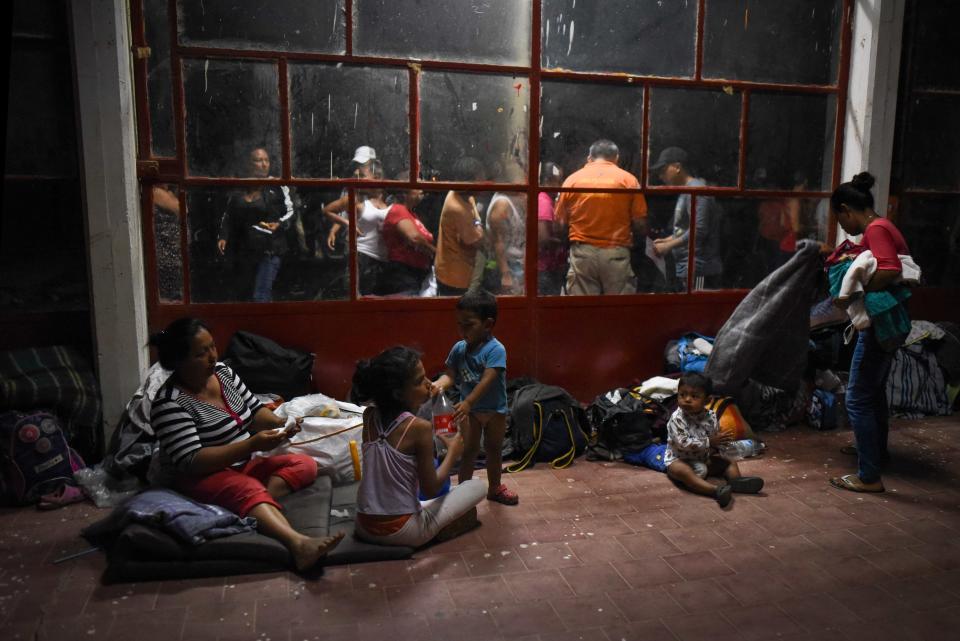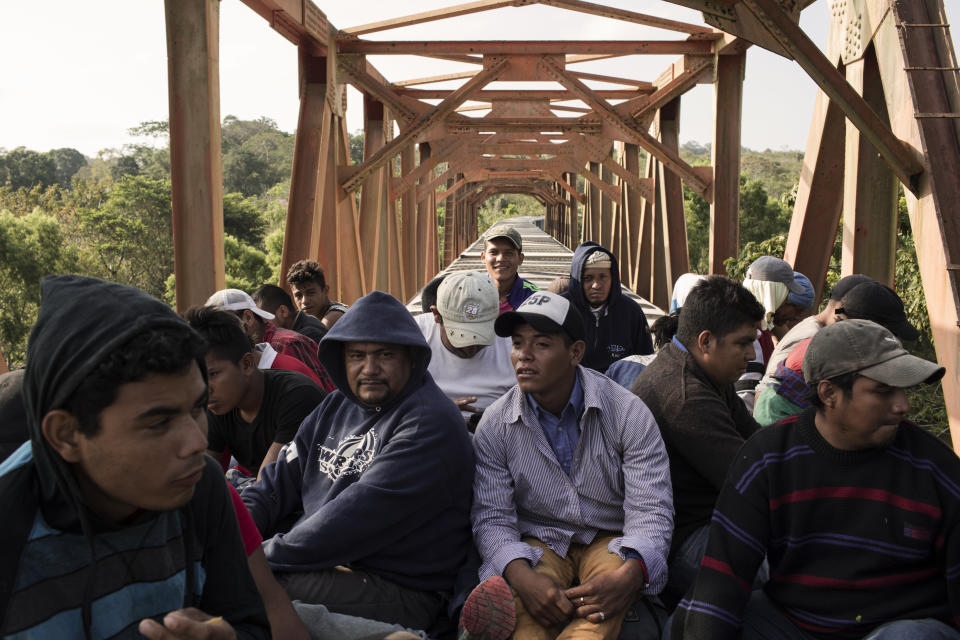Here's The Truth About The Caravan Of Migrants Trump Keeps Going On About

SAN PEDRO SULA, Honduras ― For the past two weeks, President Donald Trump and Fox News have taken turns warning Americans of a “big Caravan of People from Honduras” headed for the United States. As the “refugee caravan” makes its way through Mexico, Trump has insinuated the group will pour into the U.S. unchecked, bringing in drugs and crime, and he called for the National Guard to reinforce the border.
Trump’s warnings are detached from reality. Here’s the real story: The caravans have been organized since about 2008 to help migrants from Central America find refuge in the United States or Mexico. Eighty percent of the people who joined this year came from Honduras. And as chronic violence and a deep political crisis roil their home country, Trump’s harsh rhetoric and U.S. policy in the region have done little to deter them from seeking safety.
On March 25, the refugee caravan set off from southern Mexico with more than 1,000 migrants. On Friday, about 600 people embarked on the last leg of the trip, from Mexico City to the U.S. border.
Corruption, unrelenting violence and rampant inequality have long driven Hondurans to leave. But last year’s contested presidential election has eroded the little confidence Hondurans had in their government even more.
“Honduras was on fire and the election crisis threw gasoline on it,” said Joaquin Mejía, a Honduran security expert and human rights lawyer. “It unmasked the reality of the country ― our institutions are broken and the president, because of the elections, has no legitimacy.”

President Juán Orlando Hernández, a conservative U.S. ally, narrowly beat Salvador Nasralla, a sportscaster leading a left-wing coalition, on the Nov. 26 ballot. But amid reports of fraud and irregularities, thousands of Hondurans took to the streets. The Hernández government cracked down ruthlessly. The security forces, long marred by reports of extrajudicial killings, kidnapping and extortion, brutally put down the street protests. At least 22 civilians were killed amid the post-election protests.
Since the election, the government has intensified its crackdown on dissent. Security forces have detained protesters arbitrarily and intimidated members of the oppositions in their homes, human rights groups reported. Brenda Mejía, a lawyer for the human rights group ERIC, said her group has assisted 105 Hondurans fleeing political persecution in recent months.
As the government dealt with the uproar in the streets, the turmoil created an opening for the gangs. Criminal gangs have controlled large sections of Honduras since the 1990s, and their activities have contributed to making Honduras one of the deadliest places in the world. The homicide rate fell considerably under Hernández, from 88.5 murders per 100,000 inhabitants in 2011 to 43.6 per 100,000 in 2017, partly because of a fierce campaign from the Honduran security forces.
As the gangs stepped up their activities following the elections, the security forces responded in kind. In San Pedro Sula, a city in Honduras’ north where protests were most violent, citizens were caught in between.
“More people have been forced to leave because the gangs have reactivated in the chaos in the last few months to intensify recruitment and expand territory,” said Nahun Maldonado, who runs the San Padro Sula operations for World Vision, a nongovernmental organization that works with deportees.
“We are seeing kids who are also threatened and beaten by police, so they’re just leaving,” Maldonado continued. He added that the community has been worried by reports of youth disappearing after being picked up by police.
“We haven’t seen them since,” he said. “We don’t know if they were killed, or if the kids managed to flee to another country.”

Amid the worsening instability, chronic problems remain unresolved. Hernández’s first term was marred by allegations of human rights violations and corruption. State security agencies were involved in the murder of environmental activist Berta Caceres while Hernández’s 2013 campaign received funds from companies tied to the theft of millions from the country’s social security agency.
In the first months of Hernández’s second term, abuse and graft have continued unabated. In January, the National Congress moved to protect lawmakers from prosecution for embezzlement, after five of its own members were charged for lining their coffers with government funds for social programs in December.
Prior to the election, more than 60 percent of Hondurans remained unemployed or underemployed while over a quarter of youth ages 15-24 were not in schools or at jobs. Little has changed since. Reforms in education, health and infrastructure have remained elusive. To make matters worse, transportation shut down and exports were limited during the protests, leaving people who earned little income to scramble.
Amid the growing political instability and the disillusionment with the Hernández government, Mexico’s immigration agency reported a 168 percent jump in the number of Hondurans arriving from December to February; U.S. officials registered a 66 percent increase from December to March.
The stories of the Hondurans in this year’s refugee caravan ― families traveling with small children, single men with their few possessions stuffed in backpacks, teens who left their houses on their own ― drive home the severity of the crisis.
“If I could offer something to my kids in Honduras, don’t you think I would be there?” wondered Carlos Soto, 28, an appliance salesman from San Pedro Sula whose business closed. Soto spoke to HuffPost in early April from a soccer field in Matías Romero, Mexico, where the caravan stayed for nearly a week, while in negotiations with the Mexican government.
Esperánza, who is being identified by first name only to protect her identity, said gang members had kidnapped and raped her 18-year-old daughter after Esperánza was unable to pay the gangs the traditional “war tax” for her tortilla business. Even after leaving her home, in the manufacturing town of Choloma, the attacks on her family had continued.
“Eight days ago, they cut my nephew to pieces,” she told HuffPost as she walked down the highway on an early morning of the caravan.
Despite the reports of corruption and human rights violations, the United States continues to see Hernández as one of its closest allies in the region. The U.S. has provided millions of dollars in aid to the Hernández administration to stem violence, migrants and contraband. In 2017, on top of military aid, Honduras received a cut of a $655 million assistance package for Central America.
Love HuffPost? Become a founding member of HuffPost Plus today.

The Trump administration recognized Hernandez’s victory despite controversy over the vote and has stayed quiet on the growing instability in the country since. Two days after the contested election, the U.S. State Department certified Honduras had made progress on improving human rights and fighting corruption, paving the way for millions of dollars in aid to be released.
“While protesters were being shot dead in the street and the Organization of American States was calling out the Honduran government’s dirty tricks, the Trump administration chose to put its head in the sand and say there was nothing to see,” said Rep. Norma Torres (D-Calif.), the founder and co-chair of the Central America Caucus in the U.S. House.
Experts say the State Department thought its recognition of Hernández’s victory would bring some stability after a month of protests and no announced winner.
“Nobody thought there would be as much political violence afterward,” said Eric Olson, an expert on Central America at the Woodrow Wilson International Center for Scholars in Washington, D.C.
Irineo Mujica, the director of Pueblo Sin Fronteras, the group that organizes the caravan, said the U.S. has turned a blind eye to the government’s role in the crisis and has failed to address “the roots of the problem.” Consistent arms sales continue to fuel violence from all sides, Mujica said, noting both the gangs and police use U.S. weapons. Due to lax U.S. gun laws, nearly 50 percent of weapons found and traced at crime scenes in Honduras originate from the United States. Mujica also criticized policy focusing on anti-trafficking initiatives instead of reducing demand for drugs in the U.S., which has yet to stem the flow of narcotics.

Trump has consistently conflated Central American migrants with members of gangs like MS-13, even though many Hondurans joined the caravan precisely to escape the gangs. And while migrants have a right under both international and U.S. law to seek asylum at the border, Trump has continuously voiced his opposition to their arrival. He urged Mexican authorities to prevent the caravan from reaching the United States, called for 4,000 members of the National Guard to be deployed to the border and urged U.S. lawmakers to vote for stricter immigration laws.
“I’m not a terrorist, not a Nazi, not anything of a sort. I’m just going to be one more person on American soil, but for Donald Trump that’s prohibited,” José, who is being identified by first name only to protect his identity, told HuffPost before boarding a series of trains and buses to the U.S.-Mexico border.
Sitting under a tree in a Mexican railroad town, pushing his brimmed hat back on his head to protect him from the sun, the lanky 18-year-old from San Pedro Sula told HuffPost four gang members cornered him in the door of a bus in January ― two in front of him and two behind. He recognized the sun tattoo on the arm of one, the image of the Virgin Mary on the arm of another. He remembered the exact words they used to threaten him: “If you don’t listen to us, we’re going to kill you. And you know that we’re in control wherever you go.”
The gang had tried to recruit him for months. They had promised him fancy clothes, new shoes and a more upscale lifestyle. When he refused, they beat him up, forcing him to move to a new school. As their stalking became more intense, he moved out of his mother’s neighborhood. They killed a cousin who worked on a transportation route and a man whom José considered to be like a grandfather. As far as he knows, the police never made arrests in either case.
The size of the caravan has dwindled in the past few weeks because many of the immigrants have ventured onward on their own. Many have decided to stay in Mexico, some with the intent of requesting a visa or refugee status there. On Friday, about 600 migrants continued the last part of the journey as a group, mainly by train.
José headed to the northern city of Ciudad Juárez, where he plans to save up money by working in house painting, car repair or construction, while living with other people he met through the caravan. He dreams of crossing into the United States, eventually: “I’m heading north, if God allows.”
Maya Averbuch reported from Matías Romero and Mexico City, Mexico. Sarah Kinosian reported from San Pedro Sula, Honduras.
This article originally appeared on HuffPost.
